Inside the Titan Supercomputer: 299K AMD x86 Cores and 18.6K NVIDIA GPUs
by Anand Lal Shimpi on October 31, 2012 1:28 AM EST- Posted in
- CPUs
- IT Computing
- Cloud Computing
- HPC
- GPUs
- NVIDIA
Introduction
Earlier this month I drove out to Oak Ridge, Tennessee to pay a visit to the Oak Ridge National Laboratory (ORNL). I'd never been to a national lab before, but my ORNL visit was for a very specific purpose: to witness the final installation of the Titan supercomputer.
ORNL is a US Department of Energy laboratory that's managed by UT-Battelle. Oak Ridge has a core competency in computational science, making it not only unique among all DoE labs but also making it perfect for a big supercomputer.
Titan is the latest supercomputer to be deployed at Oak Ridge, although it's technically a significant upgrade rather than a brand new installation. Jaguar, the supercomputer being upgraded, featured 18,688 compute nodes - each with a 12-core AMD Opteron CPU. Titan takes the Jaguar base, maintaining the same number of compute nodes, but moves to 16-core Opteron CPUs paired with an NVIDIA Kepler K20X GPU per node. The result is 18,688 CPUs and 18,688 GPUs, all networked together to make a supercomputer that should be capable of landing at or near the top of the TOP500 list.
We won't know Titan's final position on the list until the SC12 conference in the middle of November (position is determined by the system's performance in Linpack), but the recipe for performance is all there. At this point, its position on the TOP500 is dependent on software tuning and how reliable the newly deployed system has been.
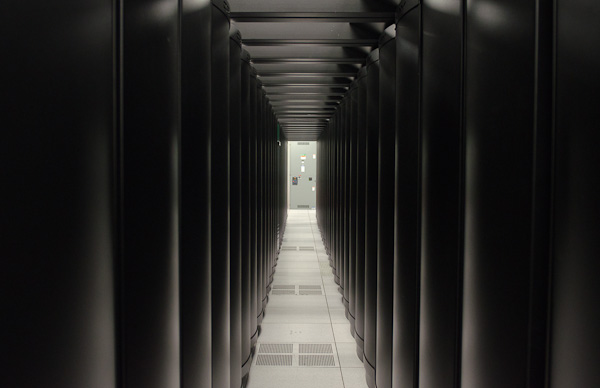
Rows upon rows of cabinets make up the Titan supercomputer
Over the course of a day in Oak Ridge I got a look at everything from how Titan was built to the types of applications that are run on the supercomputer. Having seen a lot of impressive technology demonstrations over the years, I have to say that my experience at Oak Ridge with Titan is probably one of the best. Normally I cover compute as it applies to making things look cooler or faster on consumer devices. I may even dabble in talking about how better computers enable more efficient datacenters (though that's more Johan's beat). But it's very rare that I get to look at the application of computing to better understanding life, the world and universe around us. It's meaningful, impactful compute.
The Hardware
In the 15+ years I've been writing about technology, I've never actually covered a supercomputer. I'd never actually seen one until my ORNL visit. I have to say, the first time you see a supercomputer it's a bit anticlimactic. If you've ever toured a modern datacenter, it doesn't look all that different.
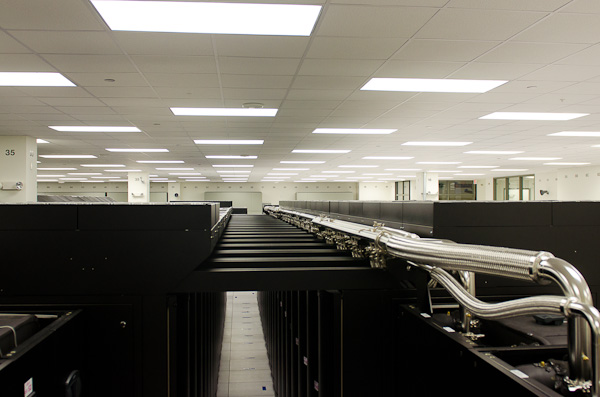
More Titan, the metal pipes carry coolant
Titan in particular is built from 200 custom 19-inch cabinets. These cabinets may look like standard 19-inch x 42RU datacenter racks, but what's inside is quite custom. All of the cabinets that make up Titan requires a room that's about the size of a basketball court.
The hardware comes from Cray. The Titan installation uses Cray's new XK7 cabinets, but it's up to the customer to connect together however many they want.
ORNL is actually no different than any other compute consumer: its supercomputers are upgraded on a regular basis to keep them from being obsolete. The pressures are even greater for supercomputers to stay up to date, after a period of time it actually costs more to run an older supercomputer than it would to upgrade the machine. Like modern datacenters, supercomputers are entirely power limited. Titan in particular will consume around 9 megawatts of power when fully loaded.
The upgrade cycle for a modern supercomputer is around 4 years. Titan's predecessor, Jaguar, was first installed back in 2005 but regularly upgraded over the years. Whenever these supercomputers are upgraded, old hardware is traded back in to Cray and a credit is issued. Although Titan reuses much of the same cabinetry and interconnects as Jaguar, the name change felt appropriate given the significant departure in architecture. The Titan supercomputer makes use of both CPUs and GPUs for compute. Whereas the latest version of Jaguar featured 18,688 12-core AMD Opteron processors, Titan keeps the total number of compute nodes the same (18,688) but moves to 16-core AMD Opteron 6274 CPUs. What makes the Titan move so significant however is that each 16-core Opteron is paired with an NVIDIA K20X (Kepler GK110) GPU.
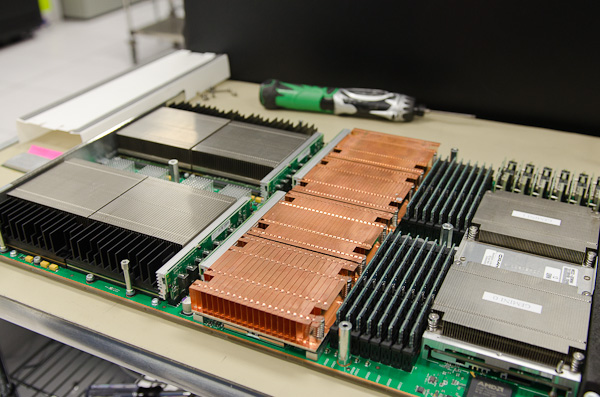
A Titan compute board: 4 AMD Opteron (16-core CPUs) + 4 NVIDIA Tesla K20X GPUs
The transistor count alone is staggering. Each 16-core Opteron is made up of two 8-core die on a single chip, totaling 2.4B transistors built using GlobalFoundries' 32nm process. Just in CPU transistors alone, that works out to be 44.85 trillion transistors for Titan. Now let's talk GPUs.
NVIDIA's K20X is the server/HPC version of GK110, a part that never had a need to go to battle in the consumer space. The K20X features 2688 CUDA cores, totaling 7.1 billion transistors per GPU built using TSMC's 28nm process. With a 1:1 ratio of CPUs and GPUs, Titan adds another 132.68 trillion transistors to the bucket bringing the total transistor count up to over 177 trillion transistors - for a single supercomputer.
I often use Moore's Law to give me a rough idea of when desktop compute performance will make its way into notebooks and then tablets and smartphones. With Titan, I can't even begin to connect the dots. There's just a ton of computing horsepower available in this installation.
Transistor counts are impressive enough, but when you do the math on the number of cores it's even more insane. Titan has a total of 299,008 AMD Opteron cores. ORNL doesn't break down the number of GPU cores but if I did the math correctly we're talking about over 50 million FP32 CUDA cores. The total computational power of Titan is expected to be north of 20 petaflops.
Each compute node (CPU + GPU) features 32GB of DDR3 memory for the CPU and a dedicated 6GB of GDDR5 (ECC enabled) for the K20X GPU. Do the math and that works out to be 710TB of memory.
System storage is equally impressive: there's a total of 10 petabytes of storage in Titan. The underlying storage hardware isn't all that interesting - ORNL uses 10,000 standard 1TB 7200 RPM 2.5" hard drives. The IO subsystem is capable of pushing around 240GB/s of data. ORNL is considering including some elements of solid state storage in future upgrades to Titan, but for its present needs there is no more cost effective solution for IO than a bunch of hard drives. The next round of upgrades will take Titan to around 20 - 30PB of storage, at peak transfer speeds of 1TB/s.
Most workloads on Titan will be run remotely, so network connectivity is just as important as compute. There are dozens of 10GbE links inbound to the machine. Titan is also linked to the DoE's Energy Sciences Network (ESNET) 100Gbps backbone.










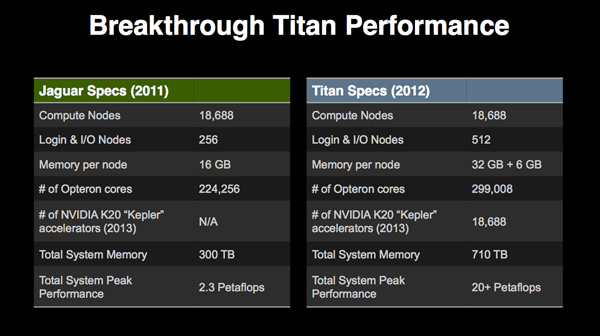
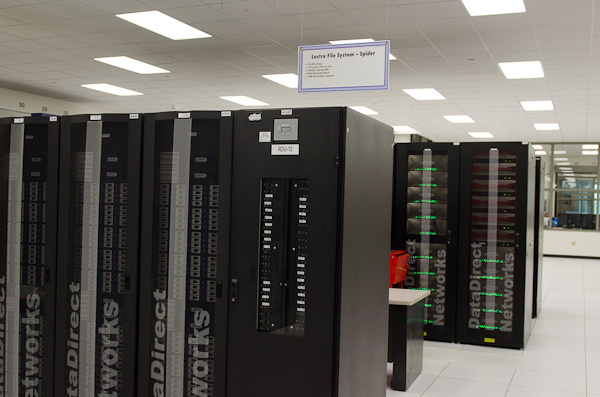
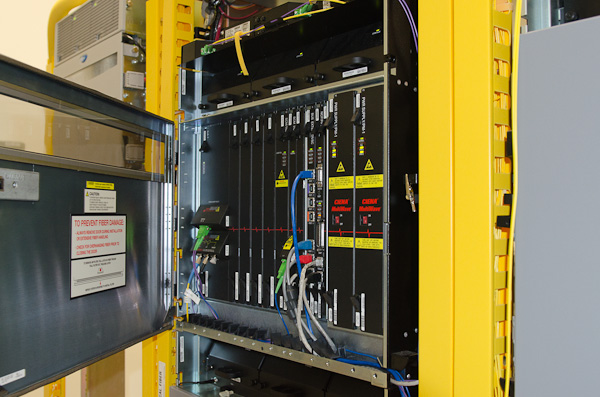








130 Comments
View All Comments
just4U - Wednesday, October 31, 2012 - link
"The evolution of Cray's XT/XK lines simply stemmed from that point, with Opteron being the supported CPU of choice."-----
I would have liked more of explaination here.. Does that mean that Intel's line doesn't work as well? Are there plans by Cray to move to Intel?
Power draw must be key. I wonder what sort of power use they'd be looking at running Intel's proccessors.
Great to see AMD in that super computer though.. I just have questions about future plans based on the current situation in the cpu market.
Th-z - Wednesday, October 31, 2012 - link
Very nice article and love your last paragraph, Anand. It's a revelation. It is indeed incredible to think when we wanted that 3D accelerator to play GLQuake, it actually turned the wheel for great things to come. To think back, something as ordinary or insignificant as gaming actually paved the way to accelerate our knowledge today. This goes to show even ordinary things can morph into great things that one can never imagine. It really humbles you to not look down anything, to be respectful in this intertwined world, the same way it humbles us as human beings as we know more about the universe.pman6 - Wednesday, October 31, 2012 - link
so that's where all of AMD's revenue came from.I was wondering who was buying AMD products
CeriseCogburn - Saturday, November 10, 2012 - link
What amd revenue ?Just look up and down, left and right here, the amd fanboys are legion - granted they can barely bone up 10 cents a week, but after a few years they can buy 2 generations back.
lorribot - Wednesday, October 31, 2012 - link
Wonder if PC game piracy will be blamed for the failure of the supercomputer industry?Braincruser - Saturday, November 3, 2012 - link
Well, you see the more someone pirates games, the more money he has to invest in hardware. So the better the hardware gets. <- nothing beats simple logic.ClagMaster - Wednesday, October 31, 2012 - link
I have been working with supercomputers for 25 years.Although parallelism is very important for processing large models, there is one important feature Mr Anand failed to discuss about Titain, choosing instead to obscess about transistor count and CPU's and GPU's.
And that is how much memory per box is available. 96GB? 256GB? of DDR3-1333 memory?
Problem is usually memory for those large reactor or coupled neutron-gamma transport problems analyzed with Monte Carlo or Advanced Discrete Ordinates, not the number of processors. Need lots of memory for the geometry, depleteable materials, and cross-section data.
And once the computing is done, how much space is available for storing the results? I have seen models so large that they run for 2 weeks with over 2000 processors only to fail because the file storage system ran out of space to store the output files.
garadante - Wednesday, October 31, 2012 - link
You failed to read the entire article. Anand stated there was something like 32 GB of RAM per CPU and 6 GB per GPU (if I remember correctly, going off the top of my head) for a grand total of 710 TB RAM total as well as 1 PB of HDD storage available. Check back through the pages to find what exactly he posted.chemist1 - Wednesday, October 31, 2012 - link
So Sandy Bridge does ~160 GFlops on the LINPACK benchmark, while Titan should do ~20 PFlops, making it 125K times faster. 125K ~ 2^17, so with 17 doublings a PC will be as fast as Titan. If we assume 1.5 years/doubling, that gives us 25 years. And just imagine the capabilities of a 2037 supercomputer....pandemonium - Wednesday, October 31, 2012 - link
What a treat, for you, to be able to witness this. Thanks for the adventurous article, Anand! :)